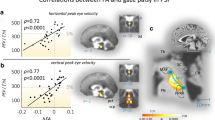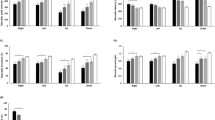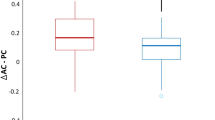Abstract
Because of the large overlap and quantitative similarity of eye movement alterations in Parkinson’s disease (PD) and multiple system atrophy (MSA), a measurement of eye movement is generally not considered helpful for the differential diagnosis. However, in view of the pathophysiological differences between MSA and PD as well as between the cerebellar (MSA-C) and Parkinsonian (MSA-P) subtypes of MSA, we wondered whether a detailed investigation of oculomotor performance would unravel parameters that could help to differentiate between these entities. We recorded eye movements during sinusoidal pursuit tracking by means of video-oculography in 11 cases of MSA-P, 8 cases of MSA-C and 27 cases of PD and compared them to 23 healthy controls (CTL). The gain of the smooth pursuit eye movement (SPEM) component exhibited significant group differences between each of the three subject groups (MSA, PD, controls) but not between MSA-P and MSA-C. The similarity of pursuit impairment in MSA-P and in MSA-C suggests a commencement of cerebellar pathology in MSA-P despite the lack of clinical signs. Otherwise, SPEM gain was of little use for differential diagnosis between MSA and PD because of wide overlap. However, inspection of the saccadic component of pursuit tracking revealed that in MSA saccades typically correct for position errors accumulated during SPEM epochs (“catch-up saccades”), whereas in PD, saccades were often directed toward future target positions (“anticipatory saccades”). The differences in pursuit tracking between PD and MSA were large enough to warrant their use as ancillary diagnostic criteria for the distinction between these disorders.



Similar content being viewed by others
References
Anderson T, Luxon L, Quinn N, Daniel S, Marsden CD, Bronstein A (2008) Oculomotor function in multiple system atrophy: clinical and laboratory features in 30 patients. Mov Disord 23:977–984
Bensimon G, Ludolph A, Agid Y, Vidailhet M, Payan C, Leigh PN (2009) Riluzole treatment, survival and diagnostic criteria in Parkinson plus disorders: the NNIPPS study. Brain 132:156–171
Brand M, Labudda K, Kalbe E, Hilker R, Emmans D, Fuchs G, Kessler J, Markowitsch HJ (2004) Decision-making impairments in patients with Parkinson’s disease. Behav Neurol 15:77–85
Briand KA, Strallow D, Hening W, Poizner H, Sereno AB (1999) Control of voluntary and reflexive saccades in Parkinson’s disease. Exp Brain Res 129:38–48
Cegalis JA, Sweeney JA (1981) The effect of attention on smooth pursuit eye movements of schizophrenics. J Psychiatr Res 16:145–161
Chan F, Armstrong IT, Pari G, Riopelle RJ, Munoz DP (2005) Deficits in saccadic eye-movement control in Parkinson’s disease. Neuropsychologia 43:784–796
Crevits L, Vandierendonck A, Stuyven E, Verschaete S, Wildenbeest J (2004) Effect of intention and visual fixation disengagement on prosaccades in Parkinson’s disease patients. Neuropsychologia 42:624–632
Drago V, Foster PS, Skidmore FM, Kluger B, Antoniello D, Heilman KM (2008) Attentional grasp in Parkinson disease. Cogn Behav Neurol 21:138–142
Gibb WR, Lees AJ (1988) The relevance of the Lewy body to the pathogenesis of idiopathic Parkinson’s disease. J Neurol Neurosurg Psychiatr 51:745–752
Gilman S, Wenning GK, Low PA, Brooks DJ, Mathias CJ, Trojanowski JQ, Wood NW, Colosimo C, Durr A, Fowler CJ, Kaufmann H, Klockgether T, Lees A, Poewe W, Quinn N, Revesz T, Robertson D, Sandroni P, Seppi K, Vidailhet M (2008) Second consensus statement on the diagnosis of multiple system atrophy. Neurology 71:670–676
Hikosaka O, Takikawa Y, Kawagoe R (2000) Role of the basal ganglia in the control of purposive saccadic eye movements. Physiol Rev 80:953–978
Hsu JL, Jung TP, Hsu CY, Hsu WC, Chen YK, Duann JR, Wang HC, Makeig S (2007) Regional CBF changes in Parkinson’s disease: a correlation with motor dysfunction. Eur J Nucl Med Mol Imaging 34:1458–1466
Hutton SB, Tegally D (2005) The effects of dividing attention on smooth pursuit eye tracking. Exp Brain Res 163:306–313
Iacono WG, Lykken DT (1979) Comments on “smooth-pursuit eye movements: a comparison of two measurement techniques” by Lindsey, Holzman, Haberman, and Yasillo. J Abnorm Psychol 88:678–680
Kitagawa M, Fukushima J, Tashiro K (1994) Relationship between antisaccades and the clinical symptoms in Parkinson’s disease. Neurology 44:2285–2289
Kollensperger M, Geser F, Seppi K, Stampfer-Kountchev M, Sawires M, Scherfler C, Boesch S, Mueller J, Koukouni V, Quinn N, Pellecchia MT, Barone P, Schimke N, Dodel R, Oertel W, Dupont E, Ostergaard K, Daniels C, Deuschl G, Gurevich T, Giladi N, Coelho M, Sampaio C, Nilsson C, Widner H, Sorbo FD, Albanese A, Cardozo A, Tolosa E, Abele M, Klockgether T, Kamm C, Gasser T, Djaldetti R, Colosimo C, Meco G, Schrag A, Poewe W, Wenning GK (2008) Red flags for multiple system atrophy. Mov Disord 23:1093–1099
Konishi S, Nakajima K, Uchida I, Kikyo H, Kameyama M, Miyashita Y (1999) Common inhibitory mechanism in human inferior prefrontal cortex revealed by event-related functional MRI. Brain 122(Pt 5):981–991
Leigh RJ, Zee DS (2006) The neurology of eye movements. Oxford University Press, Oxford
Lueck CJ, Tanyeri S, Crawford TJ, Henderson L, Kennard C (1990) Antisaccades and remembered saccades in Parkinson’s disease. J Neurol Neurosurg Psychiatr 53:284–288
Mari-Beffa P, Hayes AE, Machado L, Hindle JV (2005) Lack of inhibition in Parkinson’s disease: evidence from a lexical decision task. Neuropsychologia 43:638–646
Marino S, Sessa E, Di Lorenzo G, Lanzafame P, Scullica G, Bramanti A, La Rosa F, Iannizzotto G, Bramanti P, Di Bella P (2007) Quantitative analysis of pursuit ocular movements in Parkinson’s disease by using a video-based eye tracking system. Eur Neurol 58:193–197
Mosimann UP, Muri RM, Burn DJ, Felblinger J, O’Brien JT, McKeith IG (2005) Saccadic eye movement changes in Parkinson’s disease dementia and dementia with Lewy bodies. Brain 128:1267–1276
Nagano-Saito A, Washimi Y, Arahata Y, Kachi T, Lerch JP, Evans AC, Dagher A, Ito K (2005) Cerebral atrophy and its relation to cognitive impairment in Parkinson disease. Neurology 64:224–229
Nakamura T, Kanayama R, Sano R, Ohki M, Kimura Y, Aoyagi M, Koike Y (1991) Quantitative analysis of ocular movements in Parkinson’s disease. Acta Otolaryngol Suppl 481:559–562
Ozawa T, Paviour D, Quinn NP, Josephs KA, Sangha H, Kilford L, Healy DG, Wood NW, Lees AJ, Holton JL, Revesz T (2004) The spectrum of pathological involvement of the striatonigral and olivopontocerebellar systems in multiple system atrophy: clinicopathological correlations. Brain 127:2657–2671
Pierrot-Deseilligny C, Muri RM, Nyffeler T, Milea D (2005) The role of the human dorsolateral prefrontal cortex in ocular motor behavior. Ann N Y Acad Sci 1039:239–251
Pierrot-Deseilligny C, Muri RM, Ploner CJ, Gaymard B, Demeret S, Rivaud-Pechoux S (2003) Decisional role of the dorsolateral prefrontal cortex in ocular motor behaviour. Brain 126:1460–1473
Rascol O, Clanet M, Montastruc JL, Simonetta M, Soulier-Esteve MJ, Doyon B, Rascol A (1989) Abnormal ocular movements in Parkinson’s disease. Evidence for involvement of dopaminergic systems. Brain 112(Pt 5):1193–1214
Rivaud-Pechoux S, Vidailhet M, Brandel JP, Gaymard B (2007) Mixing pro- and antisaccades in patients with parkinsonian syndromes. Brain 130:256–264
Ross RG, Olincy A, Harris JG, Sullivan B, Radant A (2000) Smooth pursuit eye movements in schizophrenia and attentional dysfunction: adults with schizophrenia, ADHD, and a normal comparison group. Biol Psychiatry 48:197–203
Rottach KG, Riley DE, DiScenna AO, Zivotofsky AZ, Leigh RJ (1996) Dynamic properties of horizontal and vertical eye movements in parkinsonian syndromes. Ann Neurol 39:368–377
Sasaki K, Gemba H, Nambu A, Matsuzaki R (1993) No-go activity in the frontal association cortex of human subjects. Neurosci Res 18:249–252
Schlenker R, Cohen R, Berg P, Hubman W, Mohr F, Watzl H, Werther P (1994) Smooth-pursuit eye movement dysfunction in schizophrenia: the role of attention and general psychomotor dysfunctions. Eur Arch Psychiatry Clin Neurosci 244:153–160
Spengler D, Trillenberg P, Sprenger A, Nagel M, Kordon A, Junghanns K, Heide W, Arolt V, Hohagen F, Lencer R (2006) Evidence from increased anticipation of predictive saccades for a dysfunction of fronto-striatal circuits in obsessive–compulsive disorder. Psychiatry Res 143:77–88
Van Gelder P, Lebedev S, Liu PM, Tsui WH (1995) Anticipatory saccades in smooth pursuit: task effects and pursuit vector after saccades. Vision Res 35:667–678
Vidailhet M, Rivaud S, Gouider-Khouja N, Pillon B, Bonnet AM, Gaymard B, Agid Y, Pierrot-Deseilligny C (1994) Eye movements in parkinsonian syndromes. Ann Neurol 35:420–426
Vingerhoets G, Vermeule E, Santens P (2005) Impaired intentional content learning but spared incidental retention of contextual information in non-demented patients with Parkinson’s disease. Neuropsychologia 43:675–681
Waterston JA, Barnes GR, Grealy MA, Collins S (1996) Abnormalities of smooth eye and head movement control in Parkinson’s disease. Ann Neurol 39:749–760
White OB, Saint-Cyr JA, Tomlinson RD, Sharpe JA (1983) Ocular motor deficits in Parkinson’s disease. II. Control of the saccadic and smooth pursuit systems. Brain 106(Pt 3):571–587
Zee DS, Leigh RJ (1983) Disorders of eye movements. Neurol Clin 1:909–928
Zgaljardic DJ, Borod JC, Foldi NS, Mattis PJ, Gordon MF, Feigin A, Eidelberg D (2006) An examination of executive dysfunction associated with frontostriatal circuitry in Parkinson’s disease. J Clin Exp Neuropsychol 28:1127–1144
Author information
Authors and Affiliations
Corresponding author
Electronic supplementary material
Below is the link to the electronic supplementary material.
Rights and permissions
About this article
Cite this article
Pinkhardt, E.H., Kassubek, J., Süssmuth, S. et al. Comparison of smooth pursuit eye movement deficits in multiple system atrophy and Parkinson’s disease. J Neurol 256, 1438–1446 (2009). https://doi.org/10.1007/s00415-009-5131-5
Received:
Revised:
Accepted:
Published:
Issue Date:
DOI: https://doi.org/10.1007/s00415-009-5131-5




